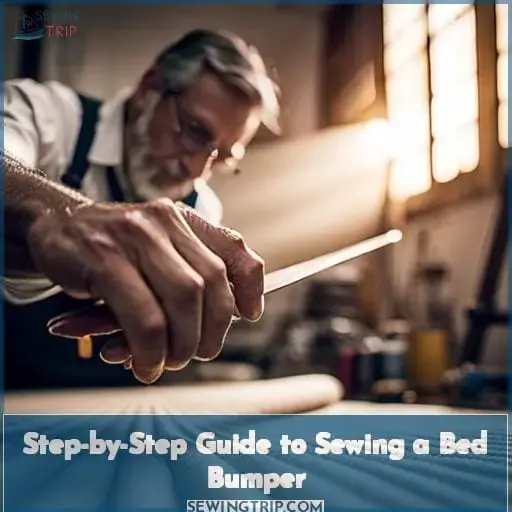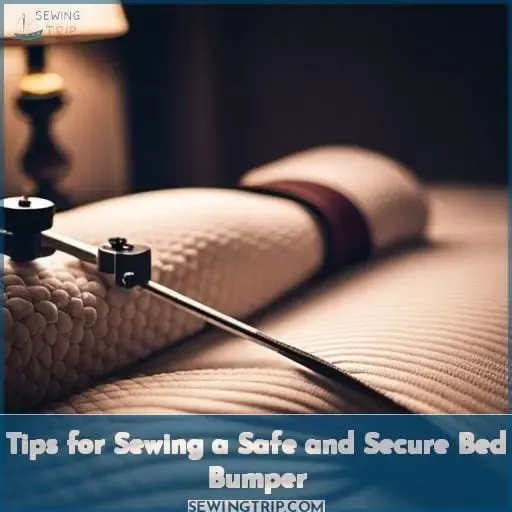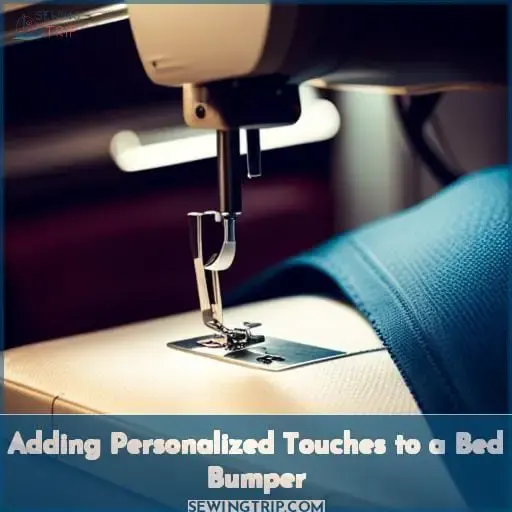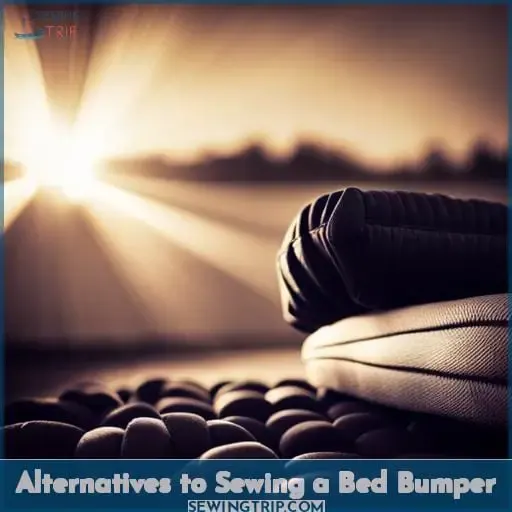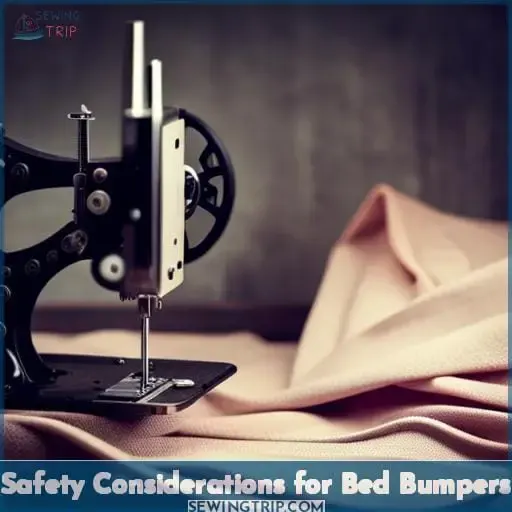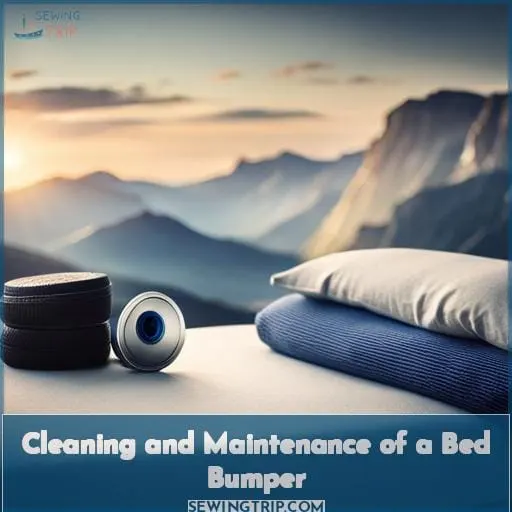This site is supported by our readers. We may earn a commission, at no cost to you, if you purchase through links.
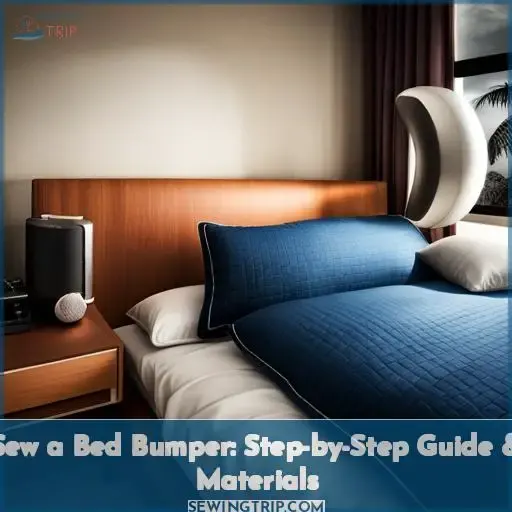 Imagine creating a safe and cozy haven for your little one as they transition from a crib to their very own bed.
Imagine creating a safe and cozy haven for your little one as they transition from a crib to their very own bed.
With our step-by-step guide, you’ll learn how to sew a bed bumper that not only adds style but also provides comfort and protection.
From choosing the right fabric to securing it in place, we’ll walk you through each detail so you can master this essential sewing project with confidence.
Get ready to create a personalized space where sweet dreams come true!
Table Of Contents
- Key Takeaways
- Materials Needed for Sewing a Bed Bumper
- Step-by-Step Guide to Sewing a Bed Bumper
- Measure the Length and Height of the Bed
- Cut Fabric and Batting to the Desired Dimensions
- Place Fabric Right Sides Together and Pin Along the Edges
- Sew Around the Edges, Leaving a Small Opening for Turning
- Turn the Bumper Right Side Out and Press
- Insert the Batting and Hand Stitch the Opening Closed
- Attach Ties or Velcro to Secure the Bumper to the Bed
- Choosing the Right Fabric for a Bed Bumper
- Tips for Sewing a Safe and Secure Bed Bumper
- Adding Personalized Touches to a Bed Bumper
- Alternatives to Sewing a Bed Bumper
- Safety Considerations for Bed Bumpers
- Cleaning and Maintenance of a Bed Bumper
- Frequently Asked Questions (FAQs)
- Conclusion
Key Takeaways
- Select soft, durable fabric for the bumper.
- Choose batting for cushioning.
- Measure the bed length and height.
- Consider safety guidelines to avoid suffocation risks.
Materials Needed for Sewing a Bed Bumper
To sew a bed bumper, you’ll need a few essential materials.
First and foremost, you’ll need fabric of your choice to create the bumper. Make sure to select a fabric that’s soft, durable, and suitable for your child’s sleep environment.
Additionally, you’ll need thread that matches or complements the fabric color for seamless stitching.
Batting is another crucial material as it provides cushioning and support to the bed bumper.
You’ll also require basic sewing tools such as scissors for cutting fabrics and batting accurately along with pins for securing them in place during sewing.
Lastly but not least important is having access to a reliable sewing machine that can handle thicker fabrics like denim or upholstery weight cotton efficiently without any hiccups.
Fabric
To sew a bed bumper, you’ll need fabric that’s:
- Stretchy
- Durable
- Waterproof
- Breathable
- Soft
- Comfortable
- Machine washable.
Thread
Now, let’s talk about the thread you’ll need for sewing a bed bumper. Use it to secure fabric together effectively.
Batting
You’ll need batting for cushioning and softness.
Choose a safe fabric.
Explore personalized designs.
Follow safety measures.
Sewing Machine
To sew a bed bumper, you’ll need:
- A sewing machine for faster and more efficient stitching.
Scissors
You’ll need a pair of scissors to cut the fabric and batting for your bed bumper.
- Choose sharp, high-quality scissors to ensure clean cuts.
- Use fabric shears specifically designed for cutting through different types of fabrics.
- Keep a separate pair of scissors dedicated solely to sewing projects for optimal performance.
- Regularly sharpen and maintain your scissors to prolong their lifespan and effectiveness in cutting fabrics accurately.
[ADDITIONAL DETAILS]:
Fabric selection:
When choosing fabric for your bed bumper, consider factors such as durability, washability, softness, and safety standards.
Safety guidelines:
Follow safe sleep guidelines when using a bed bumper by ensuring proper installation and attachment techniques.
Customization options:
Add personalized touches to your bed bumper such as appliqué shapes or letters or embroidery with the child’s name or initials.
Alternative solutions:
If you prefer not to sew a bed bumper from scratch, there are pre-made options available on the market or alternative solutions like using pool noodles or foam pipe insulation as makeshift bumpers.
Maintenance tips:
Check the care instructions provided with your chosen fabric before washing it properly spot clean any spills/stains that occur over time
Pins
To secure the fabric together while sewing, you’ll need pins.
They’re essential for keeping everything in place.
Measuring Tape
You’ll frequently use a measuring tape when sewing a bed bumper to ensure accurate dimensions.
- Measure the length and height of the bed.
- Use the measuring tape to cut fabric and batting to desired dimensions.
- Double-check measurements throughout the sewing process for precision.
Step-by-Step Guide to Sewing a Bed Bumper
Now that you have gathered all the necessary materials, it’s time to dive into the step-by-step guide for sewing a bed bumper.
First, measure the length and height of your bed to determine the dimensions of your bumper.
Cut your fabric and batting according to these measurements.
Then, place the fabric right sides together and pin along the edges before sewing around them.
Measure the Length and Height of the Bed
To start sewing a bed bumper, measure the length and height of your child’s bed for accurate dimensions.
| Measure | Length | Height |
|---|---|---|
| Bed | ___ | __ |
This step is crucial in ensuring that the bed bumper fits properly and provides effective protection against falls. By accurately measuring the length and height of the bed, you can create a custom-sized bumper that snugly fits your child’s sleep environment.
In order to measure the length of the bed, use a measuring tape to determine how long it’s from one end to another. Start at one side of the mattress and extend it all along until you reach its opposite end.
Next, measure the height or thickness of your child’s mattress by placing a ruler or measuring tape vertically against its edge. This will give you an idea of how high your bumpers should be in order to provide adequate coverage.
By taking precise measurements before starting this DIY project, you’ll ensure that your homemade bed bumper perfectly suits both bedroom safety needs and toddler transitions into their new sleeping space.
Cut Fabric and Batting to the Desired Dimensions
Now that you have measured, carefully cut your fabric and batting to size with sharp scissors.
Take care to leave seam allowances when cutting.
Consider fun, child-friendly prints that can be personalized during sewing.
Place Fabric Right Sides Together and Pin Along the Edges
To start sewing a bed bumper, gather your fabric pieces and place them right sides together, then use pins to secure the edges.
- Choose fabrics that complement the room theme while prioritizing child’s safety.
- Consider creative embellishments like appliqué or embroidery for personalization.
- Follow maintenance tips to keep the bed bumper clean and in good condition.
Sew Around the Edges, Leaving a Small Opening for Turning
Next, how do you sew around the edges while leaving a small opening?
Carefully stitch the pinned fabric, pivoting at corners, omitting a 4-inch gap for eventually turning right-side out after stuffing.
Turn the Bumper Right Side Out and Press
Once you have sewn around the edges, leaving a small opening, carefully turn the bumper right side out through the opening and press with an iron so the seams lie flat.
- Inspect the bumper for any visible stitching flaws.
- Apply a light coat of ironing starch while pressing.
- Check that corners are fully popped out.
Insert the Batting and Hand Stitch the Opening Closed
Ensure all the batting fits into the bumper thoroughly prior to stitching the small opening by hand.
Attach Ties or Velcro to Secure the Bumper to the Bed
Secure the bumper to the bed by attaching ties or Velcro for a snug fit and added safety.
Choosing the Right Fabric for a Bed Bumper
When selecting fabrics for your bed bumper, opt for materials that are:
- Soft
- Durable
- Machine-washable
Avoid loosely woven fabrics or those with small embellishments that could become choking hazards for little ones.
The best choices will coordinate with the room’s theme while prioritizing your child’s safety and your ease of care.
Consider the Style and Theme of the Room
To choose the right fabric for a bed bumper that complements the style and theme of your room, consider using fabrics with patterns or colors that match your existing decor.
Opt for Durable and Washable Fabrics
When choosing the right fabric for a bed bumper, opt for durable and washable fabrics that match the style and theme of your child’s room.
- 100% cotton
- Flannel
- Fleece
These fabrics are soft, safe for young children, and easy to launder. They also allow creative additions like appliquéd shapes or embroidered names to personalize the bumper.
Select Fabrics That Are Soft and Safe for the Child
In choosing the fabric for your child’s bed bumper, opt for soft fabrics that are free of small embellishments to ensure safety.
Consider durability and design options while keeping the child’s comfort in mind.
Avoid Fabrics With Small Embellishments That Can Become Choking Hazards
Choose fabrics that are safe for your child by avoiding small embellishments that could potentially become choking hazards.
Opt for solid fabrics or subtle prints without any beads, buttons, or appliqués that could detach and pose a danger if swallowed.
Prioritize safety first when selecting materials for a handmade bed bumper.
Tips for Sewing a Safe and Secure Bed Bumper
When sewing a bed bumper for optimal safety and security, there are several important tips to keep in mind.
First, ensure proper placement and attachment to the bed by carefully measuring and aligning the bumper with the mattress edges.
Use sturdy materials such as thick fabric or foam inserts, and reinforce seams with double stitching or zigzag stitches for added strength.
It’s crucial to avoid adding excessive padding that can pose a suffocation risk, so opt for a firm but cushioned design.
Lastly, regularly check the bumper for wear and tear to ensure it remains securely attached over time.
Ensure Proper Placement and Attachment to the Bed
To ensure a safe bed bumper:
- Properly place and attach it to the bed using sturdy safety pins through reinforced seams.
- Check it meets safety standards.
Use Sturdy Materials and Reinforce Seams
With a sturdy bed bumper, you should reinforce all seams by stitching over them twice to strengthen the barrier and prevent unraveling over time.
Opt for durable, medium-weight fabrics and interface to reinforce the shape.
Prioritize safety and customize with child-friendly fabrics.
Avoid Adding Excessive Padding That Can Pose a Suffocation Risk
When padding your handmade bed bumper, it’s crucial to avoid excessive stuffing that could pose a suffocation risk.
Use child-friendly fabrics and follow safety measures to ensure a secure and safe design.
Consider room coordination and add creative embellishments for customized designs.
Regularly Check the Bumper for Wear and Tear
To ensure the safety and longevity of your sewn bed bumper, regularly check it for wear and tear.
Inspect seams, fabric integrity, and attachment methods to maintain its durability as part of your childproofing strategy.
Adding Personalized Touches to a Bed Bumper
When sewing a bed bumper, consider personalizing it with your child’s name or initials.
You can:
- Appliqué fabric cutouts in fun shapes or letters onto the bumper.
- Embroider by hand or machine.
- Get creative with fabric paints and markers to make fun designs.
Adding these special details creates a bumper that feels custom-made for your little one.
Appliqué Fabric Shapes or Letters
Now let’s explore how you can add a personal touch to your bed bumper by appliquéing fabric shapes or letters.
Get creative and design personalized designs that reflect your child’s interests while ensuring their safety.
Choose fabrics that match the room theme and use fabric remnants for added creativity.
Secure the appliqués with safety pins before sewing them onto the bed bumper for a unique, customized look.
Embroider the Child’s Name or Initials
Personalize your bed bumper by embroidering the child’s name or initials for a special touch.
Get creative with stitching to match the child’s style and add custom embellishments.
Choose a fabric that complements the bedroom decor and gather your materials, including safety pins for securing the design in place.
Use Fabric Paint or Markers to Create Designs
Add a personal touch to your bed bumper by using fabric paint or markers to create unique designs.
Consider your child’s favorite colors, animals, or TV characters and recreate them freehand or use stencils for precision.
Let your little one join in the creativity—their small handprints or original doodles will make cherished keepsakes.
Fabric decorating allows you to customize any design for a one-of-a-kind bed bumper.
Alternatives to Sewing a Bed Bumper
Looking to skip the sewing and still keep your little one safe? Consider opting for:
- Pre-made bed bumpers
- Pool noodles or foam pipe insulation wrapped in fabric
- Removable mesh bed rails
While sewing your own custom bed bumper allows for personalization, these easy no-sew approaches offer safety too. Let’s explore some alternative bumper solutions that don’t require needle and thread.
Purchase Pre-made Bed Bumpers
If sewing a bed bumper isn’t your preferred option, you may be wondering where to find pre-made alternatives. Look for custom-designed bed bumpers or bed rail covers that offer both safety and style.
Consider the cost, safety measures, and creative embellishments available when choosing practical alternatives to sewing your own bed bumper.
Use a Pool Noodle or Foam Pipe Insulation as a Makeshift Bumper
You can also consider using a pool noodle or foam pipe insulation as a makeshift bumper for your child’s bed. These foam alternatives are affordable and easy to implement, providing an effective barrier against falls.
Here are some key points to keep in mind:
- Foam alternatives offer a budget-friendly option for bed bumpers.
- Select the appropriate size of pool noodle or foam pipe insulation.
- Ensure proper attachment and placement on the bed.
- Consider safety precautions to minimize suffocation risks.
- Personalize the bumper with fabric covers or embellishments if desired.
Using a pool noodle or foam pipe insulation as an alternative solution isn’t only cost-effective but also practical when it comes to creating a safe sleeping environment for your little one.
- Foam Alternatives: Pool noodles and foam pipe insulation serve as excellent substitutes for traditional sewn bumpers at just fraction of the cost.
- Fabric Selection: If desired, you can cover the pool noodles with fabric that matches your child’s room decor by sewing slipcovers that fit snugly around them.
- Safety Precautions: When using any type of makeshift bumper like this, always ensure secure attachment so there’s no risk of it coming loose during sleep time
- Personalized Embellishments:Add personal touches such as ribbon ties or decorative elements after securing the tubing in place
- Maintenance Tips: Regularly check both attachments’ integrity
Consider Removable Mesh Bed Rails for Added Safety
When considering alternatives to sewing a bed bumper, one option to explore is using removable mesh bed rails for added safety.
Bed rail alternatives are an effective way of childproofing bedrooms and providing DIY safety solutions.
These toddler rail options offer room safety measures and affordable bed solutions for a smooth bed transition.
Safety Considerations for Bed Bumpers
When sewing a bed bumper, it’s crucial to prioritize safety considerations.
Proper installation and attachment are essential to ensure the effectiveness of the bumper in preventing falls.
Regularly checking for any loose threads or damage is important for maintaining the integrity of the bumper over time.
Additionally, it’s vital to follow safe sleep guidelines to minimize the risk of suffocation and create a safe sleeping environment for your child.
Ensure Proper Installation and Attachment
To ensure the safety of your child, it’s important to properly install and securely attach the bed bumper.
Select sturdy fabric and reinforce the edges during sewing.
Check ties frequently, replacing loose threads promptly.
Hand wash gently, allow to fully air dry before reattaching.
Regular checks affirm continued safety.
Regularly Check the Bumper for Any Loose Threads or Damage
To ensure the safety of your bed bumper, regularly check for any loose threads or damage.
- Inspect the seams and edges for fraying or unraveling threads.
- Look for any tears, holes, or signs of wear on the fabric.
- Check that all ties or Velcro attachments are securely fastened to prevent accidents.
Regularly checking your bed bumper is an essential part of maintaining its effectiveness in providing a safe sleeping environment for your child. By conducting routine inspections, you can identify and address any potential issues before they escalate into safety concerns.
When examining your bed bumper, pay close attention to the stitching and fabric quality. Inspect each seam carefully to ensure there are no loose threads that could pose a choking hazard if pulled by curious little hands.
Additionally, check all edges of the bumper for signs of fraying or unraveling stitches which may compromise its overall stability.
Inspecting the fabric itself is equally important as it serves as both a protective barrier against falls and adds decorative appeal to your child’s room decor theme (if desired). Look out for tears, holes, or worn-out areas in the fabric that may require repair work using basic sewing techniques like patching up with additional pieces from leftover materials used during construction.
Lastly but most importantly, when performing regular checks on our homemade creations such as personalized designs sewn specifically tailored towards individual preferences – always make sure everything remains securely attached so nothing accidentally comes undone causing injury due either falling off bedsides themselves getting tangled within bedding covers leading them fall down while asleep risking serious harm instead opting alternative solutions available marketplaces catered towards parents searching quick fixes without having totally reconstruct entire set-up including purchasing pre-made bumpers alternatives such pool noodles foam pipe insulation amongst others considered reasonably priced compared their counterparts delivering similar levels protection adding peace mind knowing children safe night long!
Remember: Safety should always be prioritized above aesthetics!
Follow Safe Sleep Guidelines to Minimize the Risk of Suffocation
To ensure the safety of your child while using a bed bumper, follow safe sleep guidelines to minimize the risk of suffocation.
Create a secure sleep environment by implementing proper childproofing tips and parenting strategies.
This step-by-step guide on sewing a bed bumper with recommended materials will help you create a safe sleeping space for your little one.
Cleaning and Maintenance of a Bed Bumper
Now that you have successfully sewn your bed bumper, it’s important to know how to properly care for and maintain it.
Begin by checking the care instructions for the fabric used in your bumper.
Spot clean any spills or stains as soon as possible to prevent them from setting in.
Additionally, make sure to wash the bumper periodically to keep it fresh and hygienic.
Following these simple steps will help ensure that your bed bumper remains in excellent condition for years of use.
Check the Care Instructions for the Fabric Used
When maintaining your bed bumper, it’s important to check the care instructions for the fabric used.
Ensure that you follow proper cleaning and maintenance guidelines to keep the bumper in good condition. This will help prolong its lifespan and ensure a safe environment for your child.
Spot Clean Any Spills or Stains
You’ll want to spot clean any spills or stains on the bed bumper as soon as you notice them to prevent permanent staining.
- Gently blot the spill with a clean cloth or paper towel.
- Mix mild detergent and water, then dab the stained area with this solution.
- Rinse thoroughly and allow it to air dry before reattaching to the bed.
Cleaning Tips for Bed Bumpers:
- Always refer to the care instructions of your fabric before cleaning.
- Avoid using harsh chemicals or bleach that may damage the fabric.
- If possible, remove any removable parts (such as ties) before spot cleaning.
- For stubborn stains, consider using a stain remover specifically designed for fabrics.
By following these simple cleaning tips, you can maintain a fresh and hygienic bed bumper while ensuring its longevity in protecting your child’s safety during sleep time.
Wash the Bumper Periodically to Keep It Fresh and Hygienic
To keep your bed bumper fresh and hygienic, periodically wash it to remove any dirt or stains.
Take care of the comfort and safety of your child by following these simple cleaning steps.
Explore design variations, creative embellishments, and customization options while ensuring proper maintenance for a clean and healthy environment.
Frequently Asked Questions (FAQs)
What size bed bumper should I make?
Measure the length, width, and depth of the area you want to cover with a bed bumper.
Use those measurements to calculate the dimensions needed for your particular bed size, including the top rails and sides, allowing enough fabric to wrap around corners.
Leave excess for turning under finishing edges.
Take care to accurately gauge your interior mattress space.
Can I make a bed bumper without sewing or tools?
Yes, a bed bumper can be made without sewing or tools.
Simply use pool noodles or rolled towels secured under fitted sheets along the edges.
This creates a soft barrier that prevents falls.
Though not as durable long-term, it’s a quick DIY solution using items likely already on hand.
Is there a no-sew bed bumper I could buy instead?
Yes, there are no-sew bed bumpers you can purchase.
Look for soft foam bumpers that slip under the fitted sheet to protect little ones.
Secure options attach the bumper directly to the bed frame for added safety.
These provide the cushion and peace of mind without any sewing required.
What colors and patterns would match my child’s bedroom?
To match your child’s bedroom, consider fabrics with playful patterns like polka dots or whimsical animals.
Choose colors that harmonize with the room’s palette to create a cohesive and inviting space for sweet dreams.
Can I make a bed bumper for a crib?
You can absolutely make a bed bumper for a crib! It’s a great way to add an extra layer of safety and prevent your little one from rolling out.
Materials:
- 1 yard of fabric
- 1 yard of batting
- Fabric scissors
- Sewing machine and thread
- Safety pins
- Rotary cutter and cutting mat (optional)
Instructions:
- Cut the fabric and batting into two 24-inch by 48-inch rectangles.
- If you are using a rotary cutter and cutting mat, place the fabric and batting right sides together and cut both pieces at once.
- With right sides together, sew the two rectangles together along the long edges, using a 1/2-inch seam allowance.
- Turn the bumper cover right side out and press.
- Fold the top edge of the bumper cover down 1 inch and press.
- Stitch the top edge of the bumper cover down, using a 1/2-inch seam allowance.
- Fold the bumper cover in half lengthwise, wrong sides together, and press.
- Pin the safety pins along the top edge of the bumper cover, 1 inch apart.
- Sew the safety pins in place, using a 1/2-inch seam allowance.
- Stuff the bumper cover with batting.
- Fold the bottom edge of the bumper cover up 1 inch and press.
- Stitch the bottom edge of the bumper cover down, using a 1/2-inch seam allowance.
- Turn the bumper cover right side out and press.
- Your bed bumper is finished!
Conclusion
To create a safe and cozy haven for your little one as they transition from a crib to their very own bed, follow our step-by-step guide on how to sew a bed bumper.
With the right materials and our easy-to-follow instructions, you’ll be able to sew a personalized and stylish bed bumper that provides comfort and protection.
From choosing the right fabric to securing it in place, you’ll master this essential sewing project with confidence.
Sew a bed bumper today and create a personalized space where sweet dreams come true!


